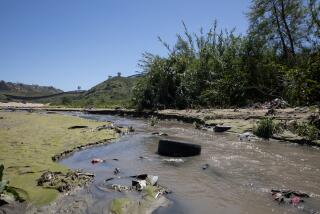Putrid Border River Typifies Pollution Crisis : Environment: The foul New River on the U.S.-Mexico boundary carries the wastes of a million people. It and other border rivers exemplify the worsening health-protection problems facing the two countries.
CALEXICO, Calif. â The New River, once a pure stream teeming with wildlife, today has deteriorated into a putrid, open sewer carrying the wastes of a million people.
Every day, Mexicali, Mexico, dumps up to 23 million gallons of untreated sewage into the New River, which then flows northward into California and the Salton Sea.
The river, a swirling, olive-green soup of chemicals and bacteria, reeks of dead animals, industrial waste and human excrement. Thirty feet from the United States border, a huge sewer pipe in Mexicali pours foaming green effluent into the river, which immediately flows through downtown Calexico.
The devastation of New Riverâs ecosystem graphically illustrates the worsening water-pollution crisis along much of the U.S.-Mexican border.
Experts say there is only one answer to the problem: help from the United States.
American taxpayers will have to shell out millions of dollars to build sewage-treatment plants and sewer systems for Mexican cities, whose populations are exploding.
In some places, American assistance already is being made available. For instance, Texas voters recently approved spending $2.2 million to help Mexico install treatment facilities along the Rio Grande. The U.S. Congress will add nearly $20 million more.
But in places such as Calexico, which abuts Mexicali, problems are still getting worse, with no solutions in sight.
Phil Gruenberg of the California Regional Water Quality Control Board monitors the New River regularly. He calls the river âa serious public health hazard.â Its water is âloaded with pathogens,â and rife with âwater-borne diseases--typhoid, hepatitis, diphtheria,â he warned.
Dead animals and garbage are routinely dumped into the river in Mexico, Gruenberg said. To his dismay, he also sees illegal aliens swimming the river to avoid the Border Patrol, despite signs warning against contact with the water.
How polluted is this river? The Environmental Protection Agency requires that shellfish not be eaten from any water in which the fecal coliform (bacteria) count per milliliter is more than 14. In the New River, the average count during the last year was 5,270,000.
One hundred miles to the west, the situation is nearly as grim where the Tijuana River crosses into San Ysidro, Calif. A longtime resident complained that the river has been destroyed.
âIt was already bad 10 years ago when it was milky-green. Now itâs black,â he said.
U.S. farmers who graze cattle and horses on the Tijuana Riverâs flood plain grumble that during heavy rains, Mexicoâs sewage spills out of the banks and onto feeding areas. In one area near San Ysidro, fields are littered with sewage and trash that overflowed in an earlier storm.
Californians, who already are grappling with a tide of illegal drugs and undocumented aliens crossing the border, protest that Washington has also let them down on the international pollution problem.
Sheriff Oren Fox of Imperial County considers New River pollution to be the No. 1 problem in his region.
âItâs a political issue (with Mexico) that our government really doesnât want to push, but it should be pushed,â he said.
Despite local unhappiness here, federal officials say there are some favorable developments.
Narendra Gunaji, the U.S. commissioner with the International Boundary and Water Commission in El Paso, said water quality is now the top priority of the commission. He characterized the overall prospects for finding solutions as âpretty good.â
Gunaji cited U.S. and Mexican willingness to share costs as one positive sign. He also pointed to the improving relationship between both governments.
Bob Yvarra, a spokesman for the international border commission, said Mexico was hard at work on its pollution problems when its economy suddenly collapsed in the early 1980s.
Mexicali, for example, was developing a treatment program for the New River, but all progress stopped in 1982. Since that time, average discharges of sewage from Mexicali have risen by 6 million gallons a day.
Progress has come faster along the Rio Grande. This year, a bilateral agreement was signed which calls for construction of a $44-million plant to treat an estimated 25 million gallons of waste daily from Nuevo Laredo, Mexico.
The project will be paid for with $22 million from Mexico and $22 million from the United States, including $2.2 million from Texas.
Normal household sewage, however, is only part of the water problem along the border.
California officials, for example, are grappling with large amounts of hazardous industrial waste in both the New River and the Tijuana River.
Gruenberg said the worst offender in Mexico along the New River is Quimica Organica, a manufacturer of pesticides and rubber products, which discharges âa variety of toxic chemicals.â
Because of Mexicoâs discharges, âthe river is practically void of any desirable forms of aquatic life for its initial 20 miles in the United States,â Gruenberg said.
Mexicaliâs industrial and household wastes are the most urgent water problem along the entire border, U.S. officials say. But for a long time, Mexico would not talk to the United States about solutions.
That led some Americans to look for answers on this side of the border. Some even joked about reversing the flow of the New River. But solutions without Mexican cooperation are all either too expensive, or impractical, according to U.S. officials.
For example, treating the entire river for pollution as it enters the United States would cost well over $100 million. But this would be an unsatisfactory answer because the flow of the river varies greatly.
Border officials say that pollution, just like the problems of illegal aliens and drugs, requires that the United States and Mexico work more closely together. Otherwise, relations along the border could worsen dramatically, they say.
More to Read
Sign up for Essential California
The most important California stories and recommendations in your inbox every morning.
You may occasionally receive promotional content from the Los Angeles Times.










